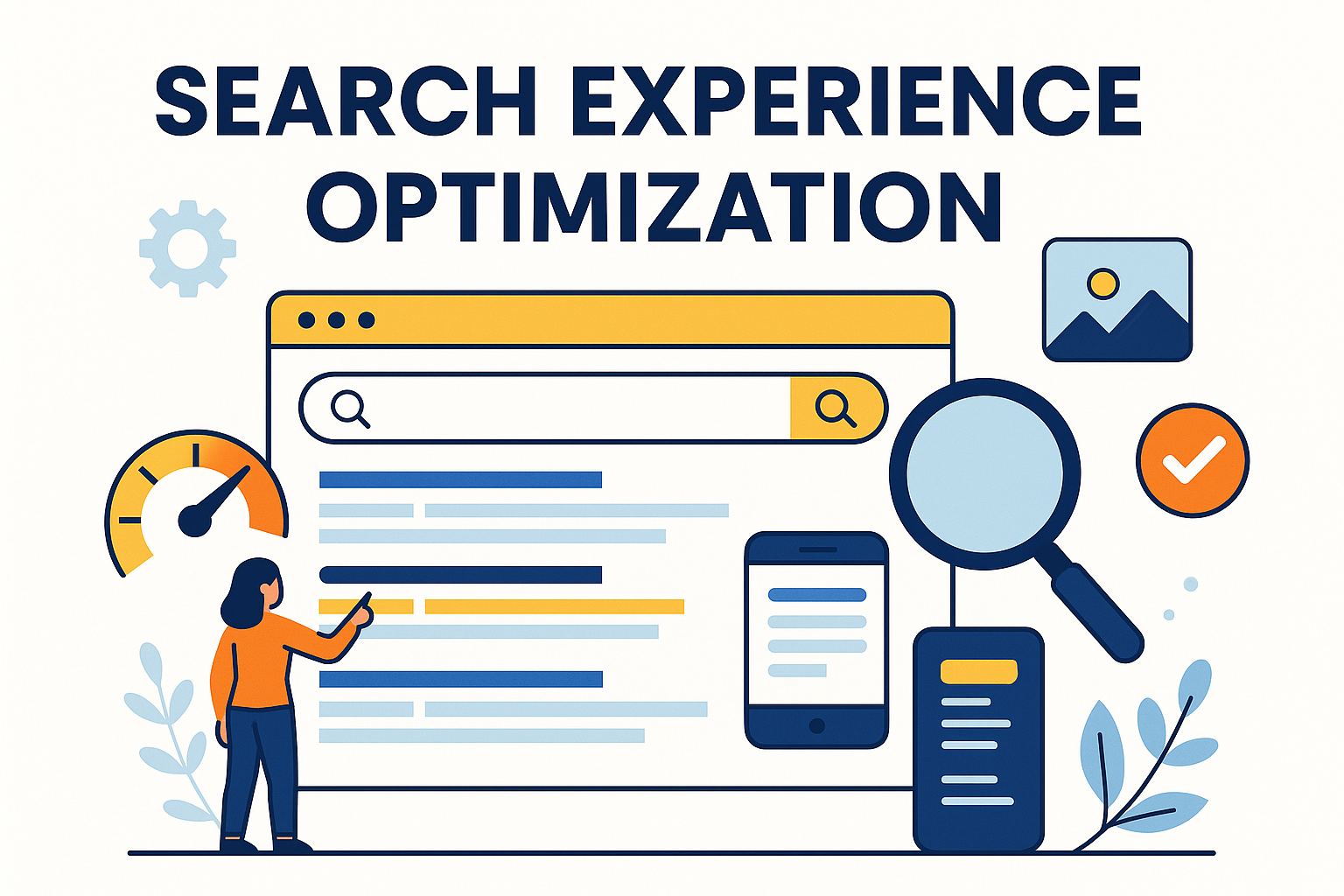What is Search Experience Optimization (SXO)?
Table of Contents
- What is Search Experience Optimization (SXO)?
- Why Search Experience Optimization (SXO) Matters
- SEO vs. (SXO) Search Experience Optimization: Key Differences
- Core Pillars of Search Experience Optimization (SXO)
- 10 Proven Strategies for Search Experience Optimization (SXO)
- Mapping Multi-Channel Search Journeys
- Content Freshness & Relevance
- Community Engagement and Social Proof
- Frequently Asked Questions (FAQs)
- Conclusion: Embrace Search Experience Optimization (SXO) for Long-Term Growth
Search Experience Optimization (SXO) is a comprehensive approach to online visibility that merges traditional search engine optimization (SEO) with an intense focus on user experience (UX).
Instead of just driving traffic, SXO ensures that users not only find your website but also enjoy their time on it, leading to higher engagement, conversions, and trust.
While many digital marketers still chase rankings and backlinks, they often overlook how a site feels when visitors arrive.
SXO bridges that gap by combining the technical precision of SEO with the emotional intelligence of user-centered design.
Why Search Experience Optimization (SXO) Matters
Today’s users are savvy and impatient. If your website loads slowly, looks outdated, or feels confusing, they’ll leave, and may never come back.
-
53% of mobile users abandon a site that takes longer than three seconds to load.
-
Poor navigation and unreadable content drastically lower trust and engagement.
Search Experience Optimization (SXO) addresses these behaviors head-on. It ensures that:
-
Users find what they need quickly.
-
Every click feels effortless.
-
Content is compelling, relevant, and easy to digest.
When visitors enjoy their journey on your site, they spend more time on it—and search engines take notice.
SEO vs. (SXO) Search Experience Optimization: Key Differences
| Traditional SEO | Search Experience Optimization (SXO) |
|---|---|
| Focuses on keywords, metadata, backlinks | Integrates UX, content clarity, page performance |
| Aims to rank high in search results | Aims to engage users post-click |
| Optimizes for bots and crawlers | Optimizes for both users and search engines |
| Measures traffic and CTR | Measures bounce rate, session time, conversions |
Traditional SEO asks: “How can I bring people to my site?”
SXO asks: “How can I make them stay and convert?”
Core Pillars of Search Experience Optimization (SXO)
1. Speed & Performance
Page speed is non-negotiable. Delays frustrate users and signal low quality to search engines.
Best Practices:
-
Compress and modernize images (e.g., WebP)
-
Minify CSS, JavaScript, and HTML
-
Use browser/server caching
-
Measure metrics like First Contentful Paint (FCP) and Largest Contentful Paint (LCP)
2. Mobile Responsiveness
With over 60% of web traffic coming from mobile devices, your design must be mobile-first.
Actionable Tips:
-
Use responsive grids and flexible layouts
-
Avoid tap targets that are too small
-
Eliminate intrusive interstitials
-
Test on real devices, not just emulators
A smooth, intuitive structure helps users explore more pages and reduces bounce rates.
How to Improve:
-
Use breadcrumb trails
-
Maintain a clear, consistent menu hierarchy
-
Link related content for deeper journeys
4. Accessible, Inclusive Design
Accessibility widens your audience and improves usability for everyone.
Checklist:
-
Use proper contrast and font sizes
-
Add alt text for all images
-
Ensure keyboard and screen reader compatibility
5. High-Quality Content
Your content must be clear, relevant, well-structured, and meet the user’s intent.
Guidelines:
-
Use short paragraphs and headings
-
Include lists, tables, infographics, and media
-
Answer common questions and cite reliable sources
6. Technical SEO Foundations
A healthy technical infrastructure makes your site easier to crawl and index.
Essential Checks:
-
Secure your site with HTTPS
-
Optimize robots.txt and sitemap.xml
-
Fix broken links and ensure clean internal linking
-
Implement structured data for rich snippets
7. Trust & Credibility
Trust drives action. Visitors want to know you’re legitimate.
Key Trust Signals:
-
Display testimonials, reviews, and badges
-
Use transparent policies and visible contact info
-
Maintain a professional, clean design
10 Proven Strategies for Search Experience Optimization (SXO)
1. Improve Page Load Speed
Use tools like Google PageSpeed Insights and GTmetrix. Identify bottlenecks, lazy-load media, and limit third-party scripts.
2. Prioritize Mobile Optimization
Design “thumb-friendly” interfaces. Use viewport scaling, responsive breakpoints, and avoid complex dropdowns.
Structure content using clear, intuitive menus and contextual internal links. Include a site search feature if necessary.
4. Elevate Content Quality
Create authoritative, helpful, well-structured content. Answer intent-rich queries and avoid fluff.
5. Strengthen Technical SEO
Ensure crawlability and indexability. Use schema markup, optimize canonical URLs, and keep sitemaps updated.
6. Guide Conversions Effectively
Use CTAs strategically. Highlight next steps (e.g., “Read more,” “Buy now,” “Subscribe”) with smart placement and persuasive copy.
7. Showcase Trust Signals
Feature real user reviews, third-party certifications, data protection notices, and strong “About Us” content.
8. Use AI Thoughtfully
Deploy chatbots, dynamic recommendations, and personalization carefully, while respecting user data.
9. Measure and Analyze Behavior
Use Google Analytics, Hotjar, or Microsoft Clarity to monitor bounce rates, scroll depth, and session replays.
10. Commit to Continuous Improvement
Regularly review metrics, update stale content, fix new UX issues, and experiment with enhancements.
Mapping Multi-Channel Search Journeys
Users often interact with your brand across:
-
Google search
-
YouTube videos
-
Blog articles
-
Social media posts
Create content for each stage of their journey. Understand:
-
What are their questions?
-
Where do they go for answers?
-
What content leads to trust?
Build consistent messaging across platforms to enhance familiarity and drive them toward conversion.
Content Freshness & Relevance
Outdated content damages trust and search rankings.
Routine Tasks:
-
Review old posts every 3–6 months
-
Update data and external links
-
Re-optimize with current keyword trends
Regular updates ensure your site remains authoritative and valuable.
Community Engagement and Social Proof
Encourage interaction:
-
Ask open-ended questions
-
Enable comments and discussion
-
Highlight top testimonials and UGC (User Generated Content)
Social signals boost credibility and can even influence rankings indirectly.
Frequently Asked Questions (FAQs)
1. What is the difference between SEO and SXO?
SEO focuses on visibility; SXO focuses on user experience post-click, blending technical and human elements.
2. Why is page speed important in SXO?
Fast-loading pages reduce bounce rates and increase satisfaction, influencing both rankings and conversions.
3. How do I know if my site has a good user experience?
Use heatmaps, analytics, and direct feedback. Monitor session time, bounce rate, and conversion paths.
4. Is mobile optimization still necessary?
Absolutely. Mobile-first indexing and the dominance of mobile traffic make it essential.
5. How does content quality affect SXO?
Better content increases engagement, dwell time, and user trust, directly impacting performance.
6. Can AI tools help improve search experience?
Yes. Tools like chatbots, personalized recommendations, and analytics automation can enhance UX when used ethically.
Conclusion: Embrace Search Experience Optimization (SXO) for Long-Term Growth
Search Experience Optimization is the future of digital marketing. It’s no longer enough to attract traffic—you must deliver an experience that turns clicks into loyal customers.
By optimizing for speed, mobile use, accessibility, content quality, and trust, you align with both user needs and search engine expectations.
Start implementing the strategies above today, measure your progress, and commit to continuous improvement.


